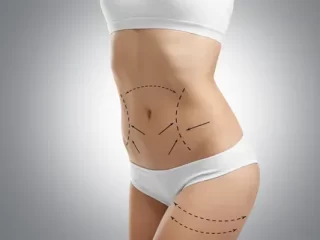Liposuction is a well-defined and popular surgical procedure that reduces localized amounts of adipose tissue in specific areas of the body to give a better shape to the patient’s body. Liposuction surgery improves the contour and proportion of your body by removing excess fat from a wide variety of areas. Liposuction is not an alternative to weight loss. Both men and women get liposuction to achieve a variety of different goals. For men, liposuction can often successfully treat gynecomastia.
Who is a good candidate for a liposuction?
The best candidates for this procedure are:
- The patient should show deviations from the normal body contour caused by excessive fat in the area.
- The patient should be within the normal body mass index.
- An ideal candidate is someone who is not obese, has minimal skin laxity, and minimal/moderately excess adipose tissue.
How is liposuction surgery performed?
In most cases, a solution is first injected into the treatment area. The solution consists of a local anesthetic, and a solution that reduces bleeding.
Fat extraction is performed using a cannula connected to a vacuum device. After the fluid is injected, the surgeon makes a small incision in your skin near the area containing the fat that is intended to be removed. A narrow metal called a cannula is inserted through the incision into the area of excess fat. The cannula is connected to a vacuum pump via flexible tubing. By moving the cannula back and forth through the fat, the surgeon can remove the fat cells. Usually, the incisions are closed with a few stitches. Since the skin is not removed during liposuction, the contraction or elasticity of the skin preserves the shape of the skin.
Are there different types of liposuctions?
Some types of liposuctions:
- Tumescent Liposuction: With this technique, a cosmetic surgeon will inject an anesthetic tumescent solution into the treatment areas to minimize bleeding and discomfort during the procedure. Depending on the patient, tumescent liposuction can often be performed with local anesthesia.
- Ultrasound Assisted Liposuction: This technique uses ultrasound energy to help break up fat tissue and loosen it from the body, allowing larger amounts of fat to be more easily removed in a faster surgery.
- Laser-Assisted Liposuction: These techniques use laser energy to help displace fat cells.
- Suction Assisted Liposuction: This technique uses a vacuum-like device to help remove fat. Power Assisted Liposuction is a similar technique that includes an instrument that increases the movement of the cannula used to remove fat.
During liposuction, fat cells are permanently removed. However, it is important to understand that your liposuction procedure will not prevent you from gaining weight. You should follow an appropriate diet and exercise plan to maintain your new shape and new weight after liposuction.
How is life after liposuction?
Liposuction surgery is a safe procedure and risks are minimized. Liposuction is an outpatient procedure after 1 day of hospitalization and recovery is usually fairly rapid. Most people can return to work within a few days and normal activities in about two weeks. The result of each person may vary depending on factors such as the volume of fat cells removed and the area where they were removed.
You can always consult experienced plastic surgeon Dr. Umut Suadiye to learn more about your personalized aesthetic needs.
References:
American Board of Cosmetic Surgery, Liposuction, https://www.americanboardcosmeticsurgery.org/procedure-learning-center/body/liposuction-guide/#:~:text=What%20is%20Liposuction%3F,a%20patient%20refine%20 their%20shape. Last Accessed: May 2023.
Cleveland Clinic, Liposuction, https://my.clevelandclinic.org/cosmetic-plastic-surgery/procedures/liposuction. Last Accessed: May 2023.
Bartow MJ, Raggio BS. Liposuction. StatPearls Publishing; 2023. https://www.ncbi.nlm.nih.gov/books/NBK563135. Last Accessed: May 2023.

